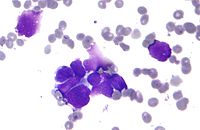
Photo from wikipedia
Generation of reactive oxygen species, a critical factor in cisplatin-induced ototoxicity, leads to the formation of peroxynitrite, which in turn results in the nitration of susceptible proteins. Previous studies indicated… Click to show full abstract
Generation of reactive oxygen species, a critical factor in cisplatin-induced ototoxicity, leads to the formation of peroxynitrite, which in turn results in the nitration of susceptible proteins. Previous studies indicated that LMO4, a transcriptional regulator, is the most abundantly nitrated cochlear protein after cisplatin treatment and that LMO4 nitration facilitates ototoxicity in rodents. However, the role of this mechanism in regulating cisplatin-induced hair cell loss in non-mammalian models is unknown. As the mechanosensory hair cells in the neuromasts of zebrafish share many features with mammalian inner ear and is a good model for studying ototoxicity, we hypothesized that cisplatin treatment induces protein nitration and Lmo4 degradation in zebrafish hair cells, thereby facilitating hair cell loss. Immunostaining with anti-parvalbumin revealed a significant decrease in the number of hair cells in the neuromast of cisplatin treated larvae. In addition, cisplatin treatment induced a significant decrease in the expression of Lmo4 protein and a significant increase in nitrotyrosine levels, in the hair cells. The cisplatin-induced changes in Lmo4 and nitrotyrosine levels strongly correlated with hair cell loss, implying a potential link. Furthermore, a significant increase in the expression of activated Caspase-3 in zebrafish hair cells, post cisplatin treatment, suggested that cisplatin-induced decrease in Lmo4 levels is accompanied by apoptosis. These findings suggest that nitrative stress and Lmo4 degradation are important factors in cisplatin-induced hair cell loss in zebrafish neuromasts and that zebrafish could be used as a model to screen the otoprotective efficacy of compounds that inhibit protein nitration.
Journal Title: Toxicology and applied pharmacology
Year Published: 2020
Link to full text (if available)
Share on Social Media: Sign Up to like & get
recommendations!